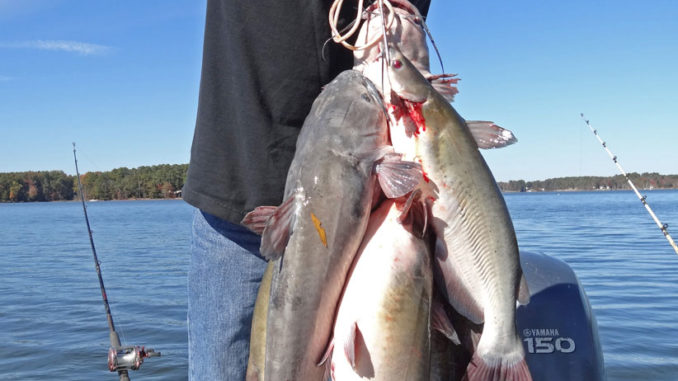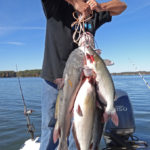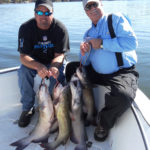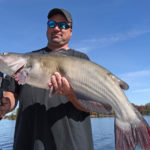
South Carolina’s Lake Murray presents anglers with a chance to catch just about every catfish possible.
The density and diversity of catfish species found in South Carolina’s Lake Murray, along with warming water temperatures, creates an outstanding opportunity to catch a cooler full of ol’ Mr. Whiskers. With abundant channel and blue catfish populations, along with plenty of flathead and white catfish, Lake Murray is a catfish haven in May.
Fishing is great across the 50,000-acre lake, but many fishermen focus on the middle to upper end because of shallower water and places to hide from recreation boat traffic.
Guide Chris Simpson enjoys spring fishing on Murray because of the potential to catch multiple species of catfish as well as trophy fish. He has witnessed the lake evolve into a top-tier catfishery.
“I think Lake Murray is one of the top, and may be the best, channel catfish lake in the state now, based on the combination of quality and quantity of catfish,” Simpson said. “The blue catfish population is excellent, with plenty of trophy fish available and excellent numbers of fish to fill the cooler. Lake Murray also has plenty of flatheads as well.
“The white catfish action is still probably the best in the state and is producing some large fish as well,” said Simpson, pointing to a 2014, state-record fish that weighed better than 12 pounds. “This lake has about everything going for it from a catfishing standpoint.”
Simpson said channel catfish average between 6 and 12 pounds, with many are in the double-digit size range. The upper range for blues and flatheads is much larger.
He begins most days keying on big channel catfish by fishing humps, ledges and points around the Dreher Island area and up the lake past the forks of the Big Saluda and Little Saluda rivers.
“I fish both anchored and drift-fishing patterns, but I’m often on a strong channel catfish pattern, and I may begin the day anchored,” he said. “The depths we’ll fish will vary during May; I often anchor in 15 to 20 feet and cast baits into both shallow and deep water, especially early or late in the day during lowlight conditions.
Simpson said as May progresses and the water warms, the day-time fishing remains good. The lake begins to stratify, and most of the catfish in this part of the lake will be less than 20 to 25 feet deep.
“Fish are in a very catchable depth range for most fishermen at this time of year,” he said. “One of my most productive methods for big channel catfish is using stinkbaits. I’ve used several with good success; both Doc’s Catfish Bait as well as Sonny’s produce well. I use a piece of sponge material, such as a piece cut from a swimming noodle, and I prefer a single, 8/0 circle hook instead of a treble hook. The circle hook does a great job and makes it much easier to unhook the fish than the treble, which catfish often swallow deep.”
Simpson will douse the sponge in the stinky goo and fan-cast rigs around the boat. A good spot produces fast and furious action, with channel catfish frequently topping 10 pounds.
“I’m very happy with any channel catfish weighing double-digits,” he said. “Early in the morning and on cloudy days we’ll catch a lot of these big fish from relatively shallow water. As the sun gets higher, the fish may move a bit deeper, but I keep baits in different depths to stay on fish movements.”
Simpson also keeps fresh cut bait out, with herring and gizzard shad two of his favorites. These baits produce channel catfish but are even better for hefty blues. A live herring or big shad give anglers the opportunity to hook a flathead.
“When using fresh cut bait or live bait, you never know what you’re going to hook into, but the potential for a big blue or flathead is much better with fresh cut or live bait,” Simpson said. “We’ll occasionally catch some big blues on the stinkbait as well. We have a good population of blue and flathead catfish in the 30-pound and larger class.”
Simpson’s other primary technique for May and into the summer is drift fishing. He’ll use multiple rods with different baits, with the odds of a mixed assortment of species highly likely.
His primary targets are underwater channel ledges along the main river and in major tributaries, as well as humps, underwater islands and creek and river junctions.
“The key is finding forage, and seeing some larger signals on the graph near the baitfish, indicates the presence of larger fish, hopefully catfish,” Simpson said. “A good drift pace is usually about 0.4 to 0.7 miles per hour. If I connect with several fish on a specific drift, I’ll work right back over the same area. If I don’t get bites, I’ll change up and move either up or down the lake a couple of miles.”
Simpson will drift with cut shad, perch, or herring. The basic drift rig he uses at Lake Murray is similar to what he’ll use at other lakes: a 3-foot leader with an 8/0 circle hook tied to a swivel, above which he places a sliding drift sinker in the 1- to 1/2-ounce weight to keep the rig in contact with the bottom. He likes 7-foot Ugly Stik catfish rods with a 25- to 30-pound main line of Berkley Big Game with a 50-pound test leader. He places a 3-inch float on the leader about a foot to 18 inches from the hook to keep the bait drifting just off the bottom, hopefully right at eyeball level for those big catfish.
Simpson said that daytime fishing is excellent in May, but as the water continues to warm and the boat traffic increases, fishing after dark becomes much more effective.
DESTINATION INFORMATION
HOW TO GET THERE — Lake Murray lies roughly between I-20 and I-26, west of Columbia. On the upper end of the 50,000-acre lake, US 378 between Lexington and Saluda is the key to accessing popular ramps: Lake Murray Estates Park, Riverbend Point, Lake Murray Shores. Visit www.lakemurrayfun.com/ramps.shtml.
WHEN TO GO — Fishing for channel cats, blues, whites and flatheads can be very good in May, especially during daylight hours.
BEST TECHNIQUES — Drifting or anchoring with a variety of baits, including stinkbaits and cut shad or herring is very productive for whites, blues and channel cats. Fish from the mid-lake area up beyond the river fork, looking for fish in 10 to 25 feet of water. For flatheads, go with live baits around points, humps and ledges.
FISHING INFO/GUIDES — Chris Simpson, Fightin Da Blues Guide Service, 864-992-2352, www.fightindablues.com. See also Guides and Charters in Classifieds.
ACCOMMODATIONS — Capital City/Lake Murray Country, 866-SC-JEWEL, www.lakemurraycountry.com.
MAPS — Navionics Electronic charts, 800-848-5896, www.navionics.com. Delorme S.C. Atlas and Gazetteer, 800-561-5105, www.delorme.com; Fishing Hot Spots, 800-ALL-MAPS, www.fishinghotspots.com; Kingfisher Maps, 800-326-0257, www.kfmaps.com.








Be the first to comment